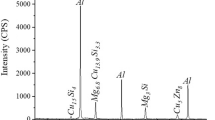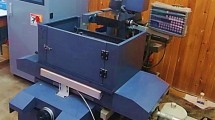Abstract
The present study focused on the machinability of Ti-3Al-2.5 V for wire-electrical discharge machining (WEDM) using "BroncoCut-X wire" (zinc-coated copper wire). The machining characteristics have been evaluated by varying wire-tension (Tw), wire-speed (Sw), flushing-pressure (Pf), discharge current (Id), and spark-on-time (Son). The response characteristics associated with cutting-speed (Cs), kerf-width (KW), and surface roughness (RA) have been collected and analyzed using main-effect plots, scanning electron microscope (SEM), and analysis of variance (ANOVA). The maximum Cs and minimum KW and RA are obtained upto 8.90 mm/min, 3.34 µm and 0.2218 mm, respectively. Additionally, the novelty lies in the smart hybrid prediction tool considering the conflicting nature of responses are converted into single responses using Grey Relation Analysis (GRA) and Fuzzy Interference System (FIS) (Namely: Gray-Fuzzy Reasoning Grade (GFRG)). Furthermore, the optimal performance is calculated using Rao-algorithms (i.e., Rao1, Rao2, and Rao3). The obtained ideal machining condition is 16N wire-tension, 3 m/min wire-speed, 8 kg/mm2 flushing-pressure, 21A discharge current, and 14 µs spark-on-time. The result has also been compared with the JAYA-algorithm and improved-grey wolf optimizer (I-GWO) to demonstrate the efficacy of the intended approach. The confirmation test has been conducted and obtained that the GFRG-based results are further improved by using a hybrid GFRG-based Rao-algorithm of 9.55%, 2.36%, and 7.99% as Cs, KW and RA, respectively. Furthermore, this study shows that the proposed multi-objective optimization method not only leads to more stable solutions but also to shorter run times and enhanced quality to support engineers in reducing the cost of item failures.























Similar content being viewed by others
Data Availability
Data will be made available on reasonable request.
References
Javidrad F et al (2014) The MPAW of Ti-3Al-2.5V thin sheets and its effects on mechanical and microstructural properties. J Mater Eng Perform 23:666–672. https://doi.org/10.1007/s11665-013-0785-7
Mahapatra S et al (2007) Optimization of wire electrical discharge machining (WEDM) process parameters using Taguchi method. Int J Adv Manuf Technol 34:911–925. https://doi.org/10.1007/s00170-006-0672-6
Puri AB et al (2003) An analysis and optimisation of the geometrical inaccuracy due to wire lag phenomenon in WEDM. Int J Mach Tools Manuf 43:151–159. https://doi.org/10.1016/S0890-6955(02)00158-X
Sree Ram H et al (2022) Prediction of Kerf width and surface roughness of Al6351 based composite in wire-cut electric discharge machining using mathematical modelling. Materials 15:1102. https://doi.org/10.3390/ma15031102
Kuriakose S et al (2004) Characteristics of wire-electro discharge machined Ti6Al4V surface. Mater Lett 58:2231–2237. https://doi.org/10.1016/j.matlet.2004.01.037
Pasam VK et al (2010) Optimizing surface finish in WEDM using the Taguchi parameter design method. J Braz Soc Mech Sci Eng 32:107–113. https://doi.org/10.1590/S1678-58782010000200002
Devarajaiah D et al (2018) Evaluation of power consumption and MRR in WEDM of Ti–6Al–4V alloy and its simultaneous optimization for sustainable production. J Braz Soc Mech Sci Eng 40:400. https://doi.org/10.1007/s40430-018-1318-y
Gupta NK et al (2021) Revealing the WEDM process parameters for the machining of pure and heat-treated titanium (Ti-6Al-4V) alloy. Materials 14:2292. https://doi.org/10.3390/ma14092292
Sharma N et al (2021) Machining of Ti-6Al-4V biomedical alloy by WEDM: investigation and optimization of MRR and R using grey-harmony search. World J Eng ahead-of-print. https://doi.org/10.1108/WJE-05-2021-0278
Wang W et al (2020) Test method for residual stress analysis of the inner surface of small caliber Ti-3Al-2.5 V tubing by X-ray diffraction. Vacuum 177:109371. https://doi.org/10.1016/j.vacuum.2020.109371
Miller M et al (2015) Effect of heat treatments on the mechanical properties of Ti-3Al-2.5 V alloy. J Mater Eng Perform 24:3277–3290. https://doi.org/10.1007/s11665-015-1628-5
Babu N et al (2021) Experimental study on mechanical and tribological behaviour of Ti-3Al-2.5 V alloy at high load condition using response surface methodology. Adv Mater Process Technol: 1–14. https://doi.org/10.1080/2374068X.2021.1945259
Singh R et al (2020) Evaluating the sustainability pillars of energy and environment considering carbon emissions under machining ofTi-3Al-2.5 V. Sustain Energy Technol Assessments 42:100806. https://doi.org/10.1016/j.seta.2020.100806
Babu N et al (2020) Multi-response optimization of process parameters in wire electric discharge machining of Ti-3Al-2.5 V alloy using Taguchi integrated grey relational analysis. Int J Mech Prod Eng Res Dev 9:233–242
Ayesta I et al (2016) Influence of the WEDM process on the fatigue behavior of Inconel® 718. Int J Fatigue 92:220–233. https://doi.org/10.1016/j.ijfatigue.2016.07.011
Rehman M et al (2020) Parametric optimization in wire electric discharge machining of DC53 steel using gamma phase coated wire. J Mech Sci Technol 34:2767–2773. https://doi.org/10.1007/s12206-020-0609-2
Sharma P et al (2016) Effect of wire material on productivity and surface integrity of WEDM-processed Inconel 706 for aircraft application. J Mater Eng Perform 25:3672–3681. https://doi.org/10.1007/s11665-016-2216-z
Prohaszka J et al (1997) The effect of electrode material on machinability in wire electro-discharge machining. J Mater Process Technol 69:233–237. https://doi.org/10.1016/S0924-0136(97)00024-1
Reolon LW et al (2019) WEDM performance and surface integrity of Inconel alloy IN718 with coated and uncoated wires. Int J Adv Manuf Technol 100:1981–1991. https://doi.org/10.1007/s00170-018-2828-6
Lin B-T et al (2007) Using response surface methodology for optimizing deposited partially stabilized zirconia in plasma spraying. Appl Surf Sci 253:3254–3262. https://doi.org/10.1016/j.apsusc.2006.07.021
Kumar A et al (2022) Experimental investigation and optimization of machining performance characteristics during WEDM of inconel 718: On evaluation of wire electrodes and advanced parameter techniques. 236: 1645–1665. https://doi.org/10.1177/09544062211023115
Kumari C et al (2020) Experimental investigations and optimization of machining parameters for Magneto-rheological Abrasive Honing process. Mater Manuf Processes 35:1622–1630. https://doi.org/10.1080/10426914.2020.1779938
Mittal P et al (2020) Many-objective optimization of hot-rolling process of steel: A hybrid approach. Mater Manuf Processes 35:668–676. https://doi.org/10.1080/10426914.2019.1655157
Zahoor S et al (2021) WEDM of complex profile of IN718: multi-objective GA-based optimization of surface roughness, dimensional deviation, and cutting speed. Int J Adv Manuf Technol 114:2289–2307. https://doi.org/10.1007/s00170-021-06916-8
Varun A, Venkaiah N (2015) Simultaneous optimization of WEDM responses using grey relational analysis coupled with genetic algorithm while machining EN 353. Int J Adv Manuf Technol 76:675–690. https://doi.org/10.1007/s00170-014-6198-4
Wang T (1985) Grey functions and relational grade. Fuzzy Math 2:59–66
Lin C-T et al (2001) Improvement of machining accuracy by fuzzy logic at corner parts for wire-EDM. Fuzzy Sets Syst 122:499–511. https://doi.org/10.1016/S0165-0114(00)00034-8
Shabgard M et al (2013) Fuzzy approach to select machining parameters in electrical discharge machining (EDM) and ultrasonic-assisted EDM processes. J Manuf Syst 32:32–39. https://doi.org/10.1016/j.jmsy.2012.09.002
Sarkodie-Gyan T et al (2009) IEEE 529–534. https://doi.org/10.1109/ROBIO.2009.5420702
Rao R (2020) Rao algorithms: Three metaphor-less simple algorithms for solving optimization problems. 11:107–130. https://doi.org/10.5267/j.ijiec.2019.6.002
Ishfaq K et al (2021) Minimizing the corner errors (top and bottom) at optimized cutting rate and surface finish during WEDM of Al6061. Eng Sci Technol Int J 24:1027–1041. https://doi.org/10.1016/j.jestch.2021.01.008
Kumar A et al (2021) Experimental investigation and optimization of machining performance characteristics during WEDM of inconel 718: On evaluation of wire electrodes and advanced parameter techniques. Proc Inst Mech Eng C J Mech Eng Sci 236:1645–1665. https://doi.org/10.1177/09544062211023115
Jadam T et al (2019) Study of surface integrity and machining performance during main/rough cut and trim/finish cut mode of WEDM on Ti–6Al–4V: effects of wire material. J Braz Soc Mech Sci Eng 41:151. https://doi.org/10.1007/s40430-019-1656-4
Khan SA et al (2021) A detailed machinability assessment of DC53 steel for die and mold industry through wire electric discharge machining. Metals 11:816. https://doi.org/10.3390/met11050816
Naveed R et al (2019) Complex taper profile machining of WC-Co composite using wire electric discharge process: analysis of geometrical accuracy, cutting rate, and surface quality. Int J Adv Manuf Technol 105:411–423. https://doi.org/10.1007/s00170-019-04150-x
Selvakumar G et al (2020) Investigation on corner accuracy in wire cut EDM of AISI D3 tool steel. Int J Rapid Manuf 9:58–70. https://doi.org/10.1504/IJRAPIDM.2020.104426
Farooq MU et al (2020) Curved profiles machining of Ti6Al4V alloy through WEDM: investigations on geometrical errors. J Mater Res Technol 9:16186–16201. https://doi.org/10.1016/j.jmrt.2020.11.067
Nair H et al (2022) Experimental investigation on material removal rate, kerf width, surface roughness and the dimensional accuracy the accuracy of hole in Inconel 718 using wire electric discharge. Proc Inst Mech Eng Part E: J Process Mech Eng: 09544089221096025. https://doi.org/10.1177/09544089221096025
Rajmohan K et al (2017) Experimental investigation and prediction of optimum process parameters of micro-wire-cut EDM of 2205 DSS. Int J Adv Manuf Technol 93:187–201. https://doi.org/10.1007/s00170-016-8615-3
Pramanik A et al (2018) Processing of duplex stainless steel by WEDM. Mater Manuf Processes 33:1559–1567. https://doi.org/10.1080/10426914.2018.1453165
Somashekhar KP et al (2010) Material removal characteristics of microslot (kerf) geometry in μ-WEDM on aluminum. Int J Adv Manuf Technol 51:611–626. https://doi.org/10.1007/s00170-010-2645-z
Mirjalili S et al (2014) Grey wolf optimizer. Adv Eng Softw 69:46–61. https://doi.org/10.1016/j.advengsoft.2013.12.007
Shastri RK et al (2021) Sustainable electrical discharge machining of Nimonic C263 superalloy. Arab J Sci Eng 46:7273–7293. https://doi.org/10.1007/s13369-020-05211-0
Khan SA et al (2021) Exploring the feasibility of novel coated wires in wire EDM of Ti-6Al-4 V aerospace alloy: a case of multi-pass strategy. J Braz Soc Mech Sci Eng 43:273. https://doi.org/10.1007/s40430-021-02994-7
Kumar V et al (2017) WEDM of nickel based aerospace alloy: optimization of process parameters and modelling. Int J Interactive Des Manuf (IJIDeM) 11:917–929. https://doi.org/10.1007/s12008-016-0298-3
Banu A et al (2017) Analysis of WEDM process parameters on surface roughness and Kerf using Taguchi method. Int J Eng Mater Manuf 2:103–109. https://doi.org/10.26776/ijemm.02.04.2017.04
Priyadarshini M et al (2019) Machining of sub-cooled low carbon tool steel by wire-EDM. Mater Manuf Processes 34:1316–1325. https://doi.org/10.1080/10426914.2019.1662035
Ishfaq K et al (2020) Optimization of WEDM for precise machining of novel developed Al6061-7.5% SiC squeeze-casted composite. Int J Adv Manuf Technol 111:2031–2049. https://doi.org/10.1007/s00170-020-06218-5
Patel JD et al (2019) WEDM process parameter selection using preference ranking method: a comparative study. Int J Manuf Res 14:118–144. https://doi.org/10.1504/IJMR.2019.099978
Chopra K et al (2019) Detailed Experimental Investigations on Machinability of EN31 Steel by WEDM. Trans Indian Inst Met 72:919–927. https://doi.org/10.1007/s12666-018-1552-0
Author information
Authors and Affiliations
Corresponding author
Ethics declarations
Conflict of Interest
All authors confirm and declare no conflict of interest.
Additional information
Publisher's Note
Springer Nature remains neutral with regard to jurisdictional claims in published maps and institutional affiliations.
Rights and permissions
Springer Nature or its licensor (e.g. a society or other partner) holds exclusive rights to this article under a publishing agreement with the author(s) or other rightsholder(s); author self-archiving of the accepted manuscript version of this article is solely governed by the terms of such publishing agreement and applicable law.
About this article
Cite this article
Kumar, A., Upadhyay, C., Kumar, N. et al. Soft Computing Based Parametric Optimization of Cutting Rate, Surface Roughness, and Kerf Width in Wire Electric Discharge Machining of High Strength Ti-3Al-2.5 V. Exp Tech (2023). https://doi.org/10.1007/s40799-023-00681-x
Received:
Accepted:
Published:
DOI: https://doi.org/10.1007/s40799-023-00681-x




